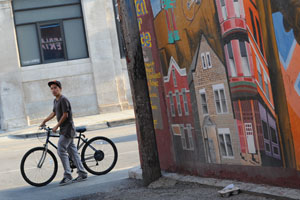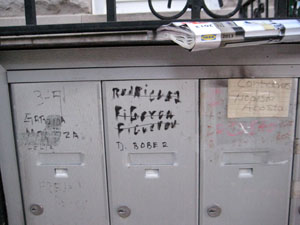Racial change in Pilsen: Mi casa? Tu casa?
By Linda Lutton

Racial change in Pilsen: Mi casa? Tu casa?
By Linda Lutton
Just as our region was becoming more Latino over the last decade, one of Chicago’s most quintessentially Latino neighborhoods was becoming less so.
Pilsen has been known as a Mexican community for a half century. But more than 10,000 Mexicans left the neighborhood in the last decade—that’s a quarter of the Hispanic population there. And non-Hispanics are moving in greater numbers.
As part of our series on race, we go beneath the surface of race relations in this gentrifying neighborhood.
For decades, Pilsen has worn its Mexican identity on its sleeve: the pushcarts, the painted walls, neon taqueria lights. Block parties and booming ranchera music. This hasn’t been the biggest Mexican community in Chicago for a long time, but it’s been the heart.
I’ve lived here 19 years. I married a Mexican artist from this neighborhood.
I see the racial change.
There’s a new mix of people on the streets, but there’s also an awkward separation. It’s like two communities in the same space. Together, but apart.
So I wanted to ask people in Pilsen what they think about each other: What it’s like to live in a Mexican neighborhood if you’re not Mexican. And what the Mexicans think about the arrival of all these white folks and others.
JANESSA: Introduce myself? Hi, my name is Janessa Lopez, and I live in Pilsen. I live on 18th and Laflin, and I’ve been in this neighborhood for just about 17 years, my whole life.
Janessa is fun and funny, she grew up playing in the alley behind her building. She boasts that she knows everybody from 16th Street to 21st. Some of that comes from sitting on the stoop outside her family’s apartment.

She told me what nearly everybody told me: that the güeros coming in is a good thing. Fewer gangs, they say. But Janessa also said this:
JANESSA: And I would say it’s a not-so-good thing, because all these rents are coming up, they’re seeing more güeros, and all of our Latino friends are leaving. I have some friends that recently, they moved. They lived here their whole lives, like me. But they just couldn’t keep up with rent. And they have white people that are willing to pay more.
Janessa’s landlord is Mexican—it’s her uncle, actually. These days, three college students live upstairs.
JANESSA: It’s really different with them up there. We don’t talk to them. They just do their thing—go to school, come back, go to school, come back. In the building we try to make a cook out, invite everybody from there—everybody else comes but them. I don’t know if it’s personal, or race or whatever. I keep insisting.
It’s like Janessa’s trying to knit the newcomers into a community that for her is unraveling.
CHARLIE: Oh, our neighbors have been great. They’ve been really welcoming.
Charlie is one of Janessa’s new upstairs neighbors. He says he loves living here. His mom used to be a teacher here, and he remembers the neighborhood from when he was a kid. He likes how people sit out in the evenings, in front of the houses. But he says that culture is not easy to join.

CHARLIE: Well in this part of Pilsen I don’t think I’m a minority by much.
That’s kind of an amazing statement. This is the very heart of Pilsen.
I told Charlie what Janessa told me. That her friends had to move out of the apartment he now lives in. They couldn’t afford the rent he and his roommates pay.
CHARLIE: Oof. I feel bad about that. Yeah.
LUTTON: You probably didn’t know that.
CHARLIE: Yeah, I had no idea who lived there before.
Charlie says he thinks for many newcomers, Pilsen is just a place to live while they’re in school.
CHARLIE: I guess that’s sort of a debate I’ve had in my head. So is it like unfair for me to live there, if I’m not a part of the community in that way. Does me being here sort of change the community because I don’t have that connection? Is it bad for the community? I don’t know. I wonder about this sometimes, you know?

Questions of race are really questions of community for Janessa and her friends too. One of them told me she gets angry just seeing white people on the streets in Pilsen. She talks about Pilsen like it’s a person, not a place. Like a family member. Pilsen has influenced me, she says.
***************
“Mexicans have this great ability to make everybody feel at home. You know, mi casa es tu casa…Come on in!”
That is artist Gabriel Villa. He’s lived in Pilsen for 14 years, about a block away from Janessa. He’s a friend of mine.
(Maybe I shouldn’t be interviewing my friends. But maybe a stranger wouldn’t have been as candid.) With the neighborhood changing, Gabriel says he thinks about race a lot.
“I think (there) is a tension that I notice in Pilsen. And I don’t think it’s about racism. I think it’s about territory. It’s about Mexicans not wanting to lose the Mexican culture, which people have worked really hard to create.”
Lately, Pilsen feels…well, less Mexican. You hear less Spanish. Taquerias and supermarkets have closed. Vintage clothing stores, Chinese restaurants, and a Subway sandwich shop have opened up. The Mexican families that used to pack the streets have disappeared.
VILLA: I love Asian culture. I love Chinatown. But I wouldn’t move there. Because by me moving in, I would just change the dynamics. I think it’s OK for cultures sometimes to group themselves. Maybe that’s really old school. I think it’s human nature.
Gabriel is genuinely grappling with all these questions. He says he has thoughts about race that he doesn’t even like having. He tells me about a new neighbor. She’s lived on the block for a few months, he says. White, 20-something. She was planting flowers under the tree near Gabriel’s apartment.
VILLA: There’s a part of me that thinks, ‘That’s really beautiful. That’s really beautiful. I mean, ‘cause they’re flowers!’ And then there’s another part of me that thinks, ‘Man, white people feel really comfortable anywhere.
Gabriel says that some years ago a friend visited him in Pilsen.
“She said, ‘You know what? When I see Mexicans here? They walk really proud.’ I knew what she was talking about. Because I think sometimes when Mexicans are the minority they kind of go inside themselves. That pride is kind of put on hold.”
“And that’s, I think, back to why people, why Mexicans are territorial. It’s because they don’t want to lose that. They want to have a place where you’re proud.”
Gabriel says he understands why young white people are attracted to Pilsen. It’s ethnic, artistic, different.
“But what I don’t understand is like, why don’t you connect more with people? But I think the reason they don’t connect is I think a lot of Mexicans don’t connect with them either. ‘Cause I see it in the street. I see it when Mexican families are on the sidewalk, and then white people pass by, I see them both kind of tilt their heads away from each other and avoid this kind of contact.”
Two worlds in the same space.
About six houses away from Gabriel is a woman I’ll call Katie.

KATIE: Wow, you guys are really tough!
RICKY: I could do it more higher!
It was Katie who planted the flowers outside Gabriel’s apartment. I asked her how she thinks the neighbors on the block perceived that.
KATIE: Oh, they love it! I talked to the people whose house is in front of that little land plot, and I chose it ‘cause it’s super sunny. And they were happy to beautify it.
Katie says she loves Pilsen for its culture…
KATIE: I would honestly be disappointed if we lost, like, the culture. And I think we would lose the culture if we lost the population density of Hispanic people in the neighborhood. It’s ironic to say, as someone who’s not, but I really hope it retains that.
Of course it’s also ironic that Katie and Gabriel want the same thing—to preserve the Mexican-ness of this neighborhood. Katie says ethnic enclaves are important, they’re a home away from home for people, she says. But she is not conflicted about living here.
KATIE: I intend to stay here, because I really like it here. At least if it is to be gentrified, the people who are not Hispanic that do move here have respect for it and try to learn, like you know those little candies that they have in those little plastic (boxes), I know the names of all of them, and like I know my favorite is jalea. Obviously, I can’t change the color of my skin, and I can’t change where I come from, but I can certainly try to have pride in something that I think is really cool.
Pilsen is still around 80 percent Hispanic.
And a group of white college girls clutching purses and shopping bags still looks pretty out of place here on 19th Street.
“Everybody keeps telling us to go to Lollapalooza—they don’t understand that we’re not here for that,” one girl says. “We’re visiting her, she just moved in like two days ago. We’re in Pilsen,” the other says.

“I don’t see why there should be a problem. This is America. Like, it’s supposed to be integrated. We’re supposed to be united. It’s not supposed to be separated.”
Lots of people would say what’s happening in Pilsen doesn’t feel like integration exactly. It feels like dual communities in a single space.
When I turn around, I realize there’s a big audience watching … a Mexican American guy on the sidewalk, his dad relaxing under a tree on the patio, mom and sister watching from a second-floor stair. The neighbors from the back apartment are hanging around too.
I cross the street and Rafa, who’s about 25, points out all the houses on the block where white people live.
RAFA: Ah, starting with the red one, then this one, then this one, this one here, then the one next door, next door, next door
LUTTON: Noooh!
RAFA: I swear to God!
His dad echoes him, pointing to the houses and saying güeros, güeros, güeros.
RAFA: Yeah, look. There’s the owner right there. You should ask him—what do you think about living with a bunch of Mexicans? (laughter) He’s gonna say I never come outside. You never see any white people coming outside, never. But as soon as we have a block party—everybody wants to eat at someone’s BBQ. ‘How’s it going, neighbor?’ Like, what the f---? I don’t know you! Right? Yeah, I’m serious!
Oh wow. I have found the Richard Pryor of Pilsen. What follows is a barrage of biting jokes, all built around race and class.
Rafa points at a white neighbor out on the sidewalk. (I’m thinking, is this really happening??)
RAFA: Look, he’s gonna go inside and look out the window. Weirdo! See? Yeah, you’re never gonna see him outside no more. Yeah! Right?
SHONTAY: When they do come out they come out in a group.
But seriously, I say to Rafa. What do you think of white people moving in? I’m totally fine with it, he says. He says white people have brought a lot of positives to the neighborhood.
RAFA: All the pavement used to be cracked. The park’s getting turf now. There was no bank right there. So, like I guess we’ve gotta say thanks to you guys, you know? No, I’m being serious. Like all these abandoned buildings would have still been abandoned if you guys didn’t have good credit.
LUTTON: You mean me, white people?
RAFA: No, I’m just saying in general! You know?
But seriously, I say. What do you really think? Your neighbors are leaving. Your new neighbors aren’t Mexican. Rafa says he’s not leaving, and he has no issues with anyone.
RAFA: Like I’ve never yelled at anybody that comes in here that’s white or said, you white this, you white that. But I’m sure if we were to go and take a drive down there and move into a house, they would just be seeing out of the blinds. That white guy? That white guy has been living there for five years—I don’t know his name. Como se llama? He don’t even say hi. And walking with a Starbucks while we walk with our Dunkin’ Donuts coffee!! F--- him! Yeah! Serious, dude! That should be your question. Go knock on his door.
As we’re talking, Rafa has said hi to just about everyone who walks by. He knows who to greet in English, who to greet in Spanish. Some kids come by, and he pulls them over. Jean is 14.
RAFA: What do you think of white people moving into Pilsen?
JEAN: I don’t really have a problem with them. Good. Sure. No problem with it. I don’t’ think anybody’s gonna have a problem with it.
Jean says there are white people in Pilsen, they just don’t come out much, he says.
LUTTON: Why is that, do you think?
JEAN: I don’t know, maybe some stereotypical thoughts that they might have. Since, you know, we’re Latinos. Yeah, see like—supposedly we’re Latinos, we’re gonna steal their stuff and stuff like that.
As we’ve been talking, the occasional white person rides by on a bike. “That’s who you should be interviewing!” Rafa tells me. And that’s when everyone decides to pull over the next güero.
Jean makes a prediction: the guy is gonna be scared. I stand out of the way, up on the sidewalk.

BIKER: (from a half block away) What do you want?
RAFA: Come here!
BIKER: What for?
The biker stops What do you want? He shouts from halfway down the block.
JEAN: Just come here. Hey, can we interview you?
BIKER: What for?
JEAN: Oh, my God. See? See?
RAFA: We’re gonna ask the questions. You do the answering.
BIKER: All right then, no interview then.
JEAN: This is what we’re talking about, see?
“He’s scared of us!” Jean shouts.
“I’m not scared,” the biker says. His arm is shaking.
I tell him I’m doing a story about race relations in Pilsen. I ask some questions, but then Jean jumps in:
JEAN: How do you think about us Hispanics?
BIKER: I don’t know—they’re just like every other people. You got an awesome heritage. I mean, Mesoamerica was dope.
Jean tells the biker he thinks he would have reacted differently if the people pulling him over had been white.
BIKER: You have some assumptions about me now.
JEAN: It seems like you were kind of like thinking we were gonna do something to you.
BIKER: Maybe I’m just a paranoid person in general. Do you think I have friends that are Mexican or Hispanic?
JEAN: I don’t think so.
BIKER: Why not?
JEAN: ‘Cause if you did, I don’t think you would have answered the way you did to us. And we’re just kids. Come on.
Jean and the biker are talking, but I’m not sure they’re getting to any sort of understanding. Jean is just a kid. Just out of 8th grade. The way he sees it, his assumptions about white people have just been confirmed.
I talk to the biker for a while by myself. He says he’s lived in Pilsen for seven years. He started out on the more gentrified side and has moved further and further west.
LUTTON: Do you feel any tension here?
BIKER: Well, yeah, I mean. Of course I feel tension. A lot of people I think have gentrification on their mind. So, there’s always like that stigma….
The biker says he notices the increase in white people here. He calls it a drag. He says Mexicans have built up the neighborhood and given it an identity.
BIKER: And now we’re slowly going to have more people come in and maybe—I don’t know—take that down. And granted, I’m one of them, but um… it’s mixed feelings, ‘cause Pilsen’s an awesome place, and you don’t want to see it change.
Oddly, people of every race told me that.







